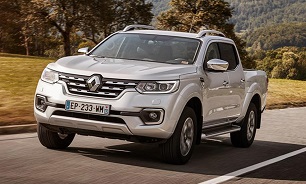Renault Alaskan 2018 review
Renault's new pickup aims to dominate South America and make inroads into the European market, but is the Alaskan different enough from the Nissan Navara?

Khodrocar - Renault’s own version of the Nissan Navara pickup truck. The Alaskan is one of three models to use the jointly developed Renault-Nissan pickup platform.
The Navara and the Mercedes-Benz X-Class are both built alongside the Alaskan at Nissan’s plant in Barcelona, although each has its own distinctive look and, in the case of the X-Class, has been fine-tuned and altered slightly to better reflect Mercedes' values.
While the project has been a collaboration from the start, the shared engine is all Renault, with a 2.3-litre four-cylinder turbo diesel unit – found in Renault Master vans – used to power the truck with two power outputs. The dCi 160 delivers 158bhp and 297lb ft of torque, while the dCi 190 develops 187bhp and 332lb ft. Both power ratings are also found in the Navara and X-Class.
The front section of the truck has been changed to give it a more familiar Renault appearance. That means a new grille, bonnet, headlight and bumper design. However, at the rear of the vehicle, only the central section of the tailgate has been altered, flattening it to make room for the large Alaskan badging.
There’s a choice of six-speed manual or seven-speed automatic transmissions with selectable four-wheel-drive and a low-range gearbox. For more ambitious off-roading, there is also the option of a locking rear differential and the Alaskan has a maximum approach angle of 30deg and departure angle of 27deg.
Maximum payload is 1035kg and it has a 3.5-tonne towing capacity. The rear load deck is 1578mm long and 1560mm wide, with a total usable area of 2.46m2.
Like the Navara, this is a proper working vehicle. Renault hasn’t changed much and nor should it need to.
The Alaskan is a vehicle built for markets where Renault has a strong market presence in countries including Argentina, Brazil and Colombia. Renault expects the Alaskan to be a global vehicle, though, and is targeting the Middle East and Europe, where it sees the Toyota Hilux and Ford Ranger as its main competitors.
The pickup must be a formidable off-roader in order for that to happen – and, fortunately, it is. Although equipped with multilink coil suspension rather than leaf springs, the Alaskan still cuts it in arduous conditions. Over gravel tracks and poor road surfaces, the front and rear coils comfortably soak up the bumps, while in extremely muddy conditions the four-wheel-drive system, electronic limited-slip differential and locking rear differential all help keep the Alaskan moving.
Features including hill descent control and hill start assist help with its off-road abilities. And although some buyers will bemoan the increased sophistication of the suspension in a segment that often demands simplicity, it allows the Alaskan to be both a tough off-roader and a comfortable vehicle on the road.
Inside, the cabin manages to be practical yet comfortable. Heated front seats with an eight-way adjustable driver’s seat ensures it is a relaxing ride, yet the pickup maintains its working abilities with a decent amount of storage. The demand for automatic transmissions in the pickup segment continues to grow and the seven-speed gearbox in the Alaskan is responsive and well matched to the 187bhp engine. The relatively small-capacity 2.3-litre engine may put some buyers off but it works well, albeit quite hard in the top power rating, with an even spread of high torque across the lower end of the rev range.
Source: Autocar
Latest News


